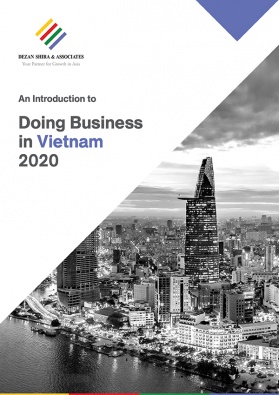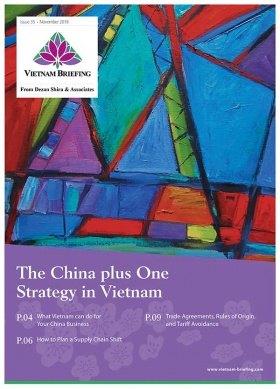The ASEAN-Hong Kong China Free Trade Agreement and Vietnam
- The ASEAN-Hong Kong China Free Trade Agreement came into effect on June 11, 2019, for Vietnam, Laos, Myanmar, Singapore, and Thailand.
- Vietnam recently issued regulations on special preferential import tariffs for the implementation of the AHKFTA effective February 20, 2020, as well as guidelines on rules of origin.
- The agreement will allow Vietnam to continue improve its competitive free trade network and move up the value chain from exporting low-tech manufacturing to high-tech goods.
Vietnam issued Decree No. 07/2020/ND-CP on the special preferential import tariffs for the implementation of the ASEAN-Hong Kong China Free Trade Agreement (AHKFTA). The decree took effect on February 20.
The AHKFTA came into effect on June 11, 2019, for Vietnam, Laos, Myanmar, Singapore, and Thailand. The remaining ASEAN member states are expected to complete the ratification process soon. The deal was first signed and agreed in November 2017 to increase economic cooperation, reduce taxes, and increase investment between regional markets and Hong Kong.
As per the Decree, the preferential import tax rates are applicable under the following conditions:
- Imported goods are listed in the special preferential import tariff under Decree 7;
- Imported from countries that are part of the AHKFTA;
- Transported directly from the exporting country part of the AHKFTA; and
- Meet rules of origin guidelines and obtain the certificate of origin (C/O).
In addition, goods that were imported after June 11, 2019, and until February 20, 2020, under the AHKFTA will be eligible for a refund if they paid tax at a higher rate.
The Ministry of Industry and Trade (MOIT) also issued Circular 21 specifying rules of origin guidelines for the AHKFTA. The origin criteria are similar to several other FTAs. Circular 21 came into effect in December 2019.
Vietnam and Hong Kong trade
Analysts have noted that with ongoing trade tensions, Hong Kong businesses are keen to expand investment opportunities in Southeast Asia, and particularly in Vietnam. At the end of 2019, Hong Kong was the second biggest investor in Vietnam. Hong Kong businesses have invested more than 1,300 projects in Vietnam on key sectors such as textiles and garments, real estate and investments. Many expect these numbers to improve following the AHKFTA.
Vietnam is Hong Kong’s third largest trade partner and biggest export market in ASEAN. In the first five months of 2019, Hong Kong accounted for 30.4 percent of total FDI investment in Vietnam, equaling US $5.08 billion.
Hong Kong’s importance as an entrepôt for trade between mainland China and Vietnam will continue to grow at a much faster pace with the FTA coming into force. Re-exports of goods of ASEAN origin through Hong Kong to China have been growing at an annual average rate of 6.4 percent since 2012.
On the other hand, re-exports of mainland China’s origin goods to ASEAN through Hong Kong have been growing at an annual average rate of 3.7 percent since 2012. Vietnam was the sixth largest destination for Hong Kong’s exports in 2018, with 60 percent being re-exports originating from the Chinese mainland. With ASEAN countries custom duties reduced or eliminated, Hong Kong’s domestic goods will become more competitive in the region.
While China has been rapidly increasing investment in Vietnam, some analysts say China is also pushing investment into through Hong Kong as Vietnam becomes more cautious about Chinese investment.
In addition to an increase in traded goods, the FTA and the Investment Agreement (IA) will encourage the service sector in ASEAN countries to take advantage of Hong Kong’s professional, financial, commercial, and legal services. The region will also benefit from increased investment flows, especially in the real estate, manufacturing, and service industry.
With increased access to Hong Kong’s trade network, its proximity to mainland China, and China’s Belt and Road Initiative, foreign and domestic firms should prepare to take full advantage of the FTA.
ASEAN-Hong Kong trade explained
Hong Kong is among the world’s most open economies, and with its liberal tariff regime, the FTA aims to increase the flow of goods and services from Hong Kong to the ASEAN countries.
The agreement covers four major areas, namely tariff reduction for goods traded, reducing restrictions for trade in services, longer stay for business travelers, and better investment protection. With respect to trade reduction, most ASEAN states will eliminate or reduce custom duties on goods from Hong Kong.
On reducing trade restrictions, both parties have agreed to remove restrictions on foreign capital participation and the number of people employed. Thailand, Vietnam, and the Philippines will also allow Hong Kong firms to take 50 percent or full ownership of firms.
On the issue of business travel, Hong Kong business visitors will be able to stay in an ASEAN country for 90 days. As of now, seven of the ASEAN member states allow Hong Kong travelers to stay for 14 to 30 days without a visa.
Hong Kong will be providing tariff free access to all products from ASEAN countries as the FTA enters into force, while for goods originating from Hong Kong, individual member states have made the following commitments on tariff reduction:
- Singapore will reduce customs duties to zero;
- Brunei, Malaysia, Philippines, and Thailand will eliminate customs duties of about 85 percent of their tariff lines within 10 years and reduce customs duties of about another 10 percent of their tariff lines within 14 years;
- Indonesia and Vietnam will eliminate customs duties of about 75 percent of their tariff lines within 10 years and reduce another 10 percent of their tariff lines within 14 years; and
- Cambodia, Laos, and Myanmar will eliminate customs duties of about 65 percent of their tariff lines within 15 years and reduce another 20 percent of their tariff lines within 20 years.
Hong Kong – ASEAN bilateral relations
As of 2018, ASEAN is Hong Kong’s second largest trading partner in merchandise trade and the fourth largest in services trade. Hong Kong’s total exports to ASEAN increased by 7.3 percent year on year to US$2.8 billion, while imports totaled US$73 billion, a 20.1 percent year-on-year increase. With China being ASEAN’s largest trading partner since 2009, trade is likely to further grow with Hong Kong increasingly handling re-export trade.
In 2018, the US $28.1 billion – or 97% – of Hong Kong’s exports to ASEAN were re-export items, of which 69.8 percent from mainland China highlighting Hong Kong’s importance as a trading hub.
Amongst the ASEAN member states, in 2018, Thailand, Singapore and Vietnam were Hong Kong’s top three trading partners at US$13.4 billion, US$12.3 billion, and US$10.7 billion of Hong Kong’s total exports with ASEAN, respectively.
Opportunities for business
With its liberal tariff regime, its position as a financial hub, a strong legal system, and excellent infrastructure, Hong Kong is an ideal location for Southeast Asian corporations.
Hong Kong has a Closer Economic Partnership Arrangement (CEPA) with China, which allows preferential market access to Hong Kong service providers and tariff-free treatment for products originating in Hong Kong. With the CEPA, ASEAN-China FTA, and AHKFTA, Hong Kong has the potential to facilitate and increase investments and trade across the region.
Hong Kong also gives access to the Pearl River Delta Metropolitan Region (PRD), an economic hub in China, and with the signing of the Framework Agreement on Deepening Guangdong-Hong Kong-Macao Cooperation in the Development of the Bay Area in July 2017, regional cooperation will continue to increase. The focus is on increasing infrastructure connectivity, enhancing market integration, developing innovation hubs, building modern industries, and increasing international cooperation.
Hong Kong will continue to be a stepping-stone for mainland Chinese firms expanding in the region and a major destination of Chinese outward investments, attracting almost 60 percent of the total Chinese outward FDI.
AHKFTA and Vietnam
The implementation of the AHKFTA will allow Vietnam to continue improve its competitive trade agreement network. It will further help the economy to move up the value chain from exporting low-tech manufacturing to exporting high-tech goods such as electronics, machinery, vehicles and medical devices as well.
Businesses leaders should take the time to understand whether their operations can benefit from AHKFTA, but also how the new deal will affect competitors and larger market conditions.
Note: This article was first published in November 2017 and has been updated to include the latest developments.
About Us
Vietnam Briefing is produced by Dezan Shira & Associates. The firm assists foreign investors throughout Asia from offices across the world, including in Hanoi and Ho Chi Minh City. Readers may write to vietnam@dezshira.com for more support on doing business in Vietnam.
- Previous Article Total Workforce Index 2019 – Drei Herausforderungen für Vietnams Arbeit
- Next Article Vietnam: Rückblick auf das Jahr 2019 und Ausblick auf 2020































